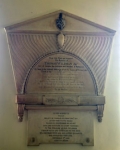Lord Uxbridges leg
Archaeology »
Archaeological Monuments » Lord Uxbridges leg
Lord Uxbridges leg - Belgium
Lord Uxbridges leg is located in Lord Uxbridge.
Lord Uxbridges leg monument was established on 1815.
Primary threats to Lord Uxbridges leg :
Lord Uxbridge's leg was shattered by a cannon shot at the Battle of Waterloo and removed by a surgeon.
Historical facts of Lord Uxbridges leg :
- Lord Uxbridge's leg is a historical curiosity that dates back to the Battle of Waterloo in 1815. Lord Henry Paget, 1st Marquess of Anglesey, famously known as Lord Uxbridge, was a prominent British military leader during the Napoleonic Wars. His leg became the center of attention due to a remarkable event that took place on the battlefield.
- Lord Uxbridge served as the second-in-command to the Duke of Wellington, leading the Anglo-Allied forces against Napoleon Bonaparte's French army. On June 18, 1815, the Battle of Waterloo unfolded near the town of Waterloo in present-day Belgium. During the intense fighting, Lord Uxbridge found himself in a precarious situation.
- As the battle raged on, a cannonball struck Lord Uxbridge's leg, severely shattering his knee. The injury was so severe that his leg had to be amputated immediately to prevent further complications. Remarkably, Lord Uxbridge remained remarkably composed despite the pain and famously quipped, "By God, sir, I've lost my leg!" to the Duke of Wellington.
- The story of Lord Uxbridge's leg gained widespread attention, not only due to the dramatic circumstances but also because of the subsequent fate of his amputated limb. After the amputation, Uxbridge's leg was buried on the battlefield. This unusual act was seen as a gesture of respect for the fallen soldiers who lay on the battlefield. It became a symbol of sacrifice and heroism.
- Following the Battle of Waterloo, Lord Uxbridge's leg became a subject of fascination. Visitors to the battlefield would often seek out the burial site to pay their respects. In 1821, a monument was erected near the spot where his leg was buried, further cementing its significance as a historical artifact.
- Despite losing his leg, Lord Uxbridge continued his military and political career. He served as the British ambassador to Austria and later held various high-ranking positions within the British government. In recognition of his services, he was appointed as the Lord Lieutenant of Ireland.
- Lord Uxbridge's leg remained a notable piece of history even after his death in 1854. In the early 20th century, the leg was exhumed and brought to the United Kingdom. It found a new home at Plas Newydd, Lord Uxbridge's family estate in Wales, where it became a popular attraction for curious visitors.
- Today, Lord Uxbridge's leg continues to be a subject of interest for historians, military enthusiasts, and visitors to Plas Newydd. It serves as a reminder of the bravery and sacrifice displayed during the Battle of Waterloo and the indomitable spirit of Lord Uxbridge himself.
- In conclusion, Lord Uxbridge's leg is a fascinating historical artifact that emerged from the Battle of Waterloo. Its amputation and subsequent burial on the battlefield symbolize the courage and resilience of those who fought in the Napoleonic Wars. This unique piece of history continues to captivate the imagination of people around the world, preserving the memory of Lord Uxbridge and the events of that fateful battle.

